Table of Contents
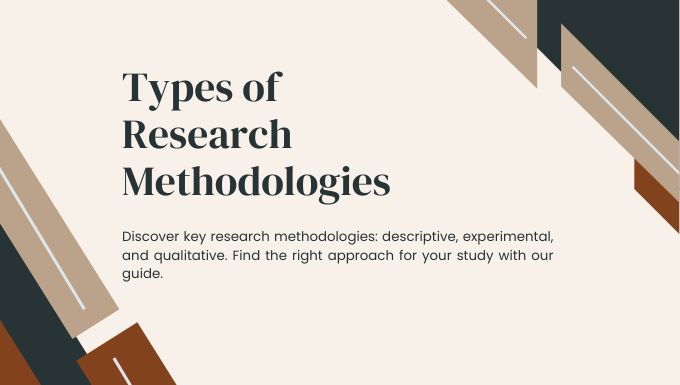
Introduction
Research methodologies are the backbone of any scientific inquiry, providing a structured framework for conducting systematic investigations. They guide researchers in gathering, analyzing, and interpreting data, ensuring that findings are reliable, valid, and replicable.
By employing rigorous methodologies, researchers can uncover meaningful insights, advance knowledge in their respective fields, and contribute to evidence-based decision-making. Thus, understanding and applying appropriate research methodologies are essential for producing credible and impactful research outcomes.
Statement of the Purpose of the Post
The purpose of this post is to highlight the significance of research methodologies in academic and scientific research, emphasizing their role in ensuring the validity, reliability, and reproducibility of research findings.
1. Descriptive Research Methodology
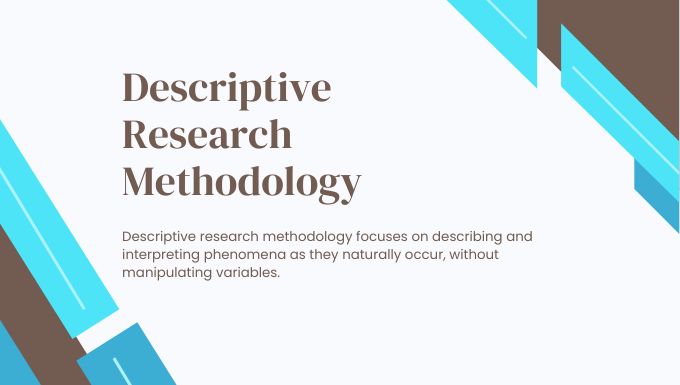
Descriptive research methodology focuses on describing and interpreting phenomena as they naturally occur, without manipulating variables. This approach aims to provide a comprehensive understanding of a particular subject or situation by collecting and analyzing data through observational methods, surveys, or case studies.
Descriptive research is valuable for identifying patterns, trends, and relationships within a given context, offering insights that can inform further investigations or practical applications in various fields.
Definition and characteristics
Descriptive research methodology is a type of research that seeks to describe and interpret phenomena as they naturally occur. Unlike experimental research, it does not involve manipulating variables but rather focuses on observing and measuring existing conditions. Characteristics of descriptive research include:
- Observational: It relies on direct observation of behavior, events, or conditions without intervening or manipulating them.
- Non-manipulative: Researchers do not alter or control variables; they simply describe them as they are.
- Quantitative or Qualitative: Data can be collected through numerical measurements or qualitative descriptions, depending on the research question.
- Cross-sectional or Longitudinal: It can be conducted at a single point in time (cross-sectional) or over an extended period (longitudinal) to track changes over time.
- Descriptive Statistics: Utilizes descriptive statistics like means, frequencies, and percentages to summarize and present the collected data.
Examples of Descriptive Research Methodologies
Examples of descriptive research methodologies include:
- Surveys: Surveys involve collecting data from a sample of individuals through questionnaires or interviews to gather information about their attitudes, opinions, behaviors, or characteristics. This method provides quantitative data that can be analyzed to identify patterns and trends.
- Case Studies: Case studies focus on in-depth analysis of a specific individual, group, or event to provide detailed insights and understanding of particular phenomena. This qualitative approach allows researchers to explore complex issues in real-life contexts.
- Observational Research: Observational research involves systematically observing and recording behaviors, events, or conditions in their natural settings without intervening or manipulating them. This method can be either structured or unstructured and provides valuable insights into human behavior and social interactions.
2. Experimental Research Methodology
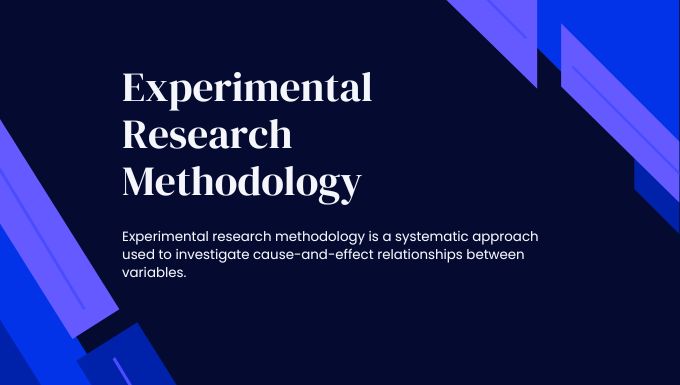
Experimental research methodology is a systematic approach used to investigate cause-and-effect relationships between variables. This method involves manipulating one or more independent variables to observe the effect on a dependent variable, while controlling for extraneous variables.
By employing rigorous experimental designs, researchers can draw reliable conclusions about the relationships between variables, thereby advancing scientific knowledge and understanding.
Definition and Characteristics
Descriptive research methodology is a type of research that aims to describe and interpret phenomena without manipulating variables. It focuses on observing and measuring existing conditions to provide a comprehensive understanding of a particular subject or situation. Characteristics of descriptive research include:
- Observational: It relies on direct observation of behavior, events, or conditions without intervening or altering them.
- Non-experimental: Researchers do not manipulate variables but describe them as they naturally occur.
- Quantitative or Qualitative: Data can be collected through numerical measurements or qualitative descriptions, depending on the research question.
- Cross-sectional or Longitudinal: It can be conducted at a single point in time (cross-sectional) or over an extended period (longitudinal) to track changes over time.
- Descriptive Statistics: Utilizes descriptive statistics like means, frequencies, and percentages to summarize and present the collected data.
Key Components of Experimental Research Methodology
In descriptive research methodology, key components like control group, experimental group, and variables are not typically used as they are in experimental research. However, it’s essential to understand these terms for a broader perspective on research methodologies:
- Control Group: In experimental research, a control group is a group of participants that does not receive the experimental treatment or intervention. It serves as a baseline for comparison to evaluate the effects of the treatment on the experimental group.
- Experimental Group: The experimental group is the group of participants that receives the experimental treatment or intervention being studied. The outcomes or responses of this group are compared to those of the control group to assess the effectiveness of the treatment.
- Variables: Variables are factors or conditions that can change or vary in research. In experimental research, there are independent variables (the factors being manipulated or tested) and dependent variables (the outcomes or responses being measured).
Although these components are fundamental in experimental research, descriptive research focuses more on describing and interpreting phenomena as they naturally occur without manipulating variables or using control and experimental groups.
Examples: Randomized controlled trials (RCTs)
Randomized controlled trials (RCTs) are not typically classified under descriptive research methodology but rather fall under experimental research designs. RCTs are considered the gold standard in clinical research for evaluating the effectiveness of interventions. Here’s a brief overview:
Randomized Controlled Trials (RCTs):
- RCTs involve randomly assigning participants to either an experimental group that receives the intervention or a control group that does not.
- They aim to determine the causal effect of an intervention by comparing outcomes between the two groups.
- RCTs use rigorous methods to control for confounding variables and biases, enhancing the validity of the results.
- They often employ blinding techniques (single-blind, double-blind) to minimize bias in outcome assessments.
- Examples of RCTs include studies evaluating the efficacy of new medications, therapeutic interventions, or behavioral treatments.
While RCTs are powerful for establishing causal relationships between interventions and outcomes, descriptive research methodologies focus on describing phenomena without manipulation or control groups, as previously discussed with examples like surveys, case studies, and observational research.
3. Exploratory Research Methodology

Exploratory research methodology is a preliminary approach used to explore and gain insights into a problem or phenomenon where limited previous research exists. It aims to identify new ideas, generate hypotheses, and provide a deeper understanding of complex issues by employing flexible and unstructured methods.
Unlike descriptive or experimental research, exploratory research does not seek to provide definitive answers or test hypotheses but rather to explore possibilities and directions for future investigations.
Definition and Characteristics of Exploratory Research Methodology
Exploratory research methodology is a preliminary research approach designed to explore and understand a problem or phenomenon where limited previous research exists. It focuses on discovering new insights, generating hypotheses, and gaining a deeper understanding of complex issues through flexible and unstructured methods. Characteristics of exploratory research include:
- Flexible Design: It allows for adaptability in research methods and approaches to best explore the research problem.
- Qualitative Methods: Often employs qualitative techniques such as interviews, focus groups, or observational studies to gather rich and detailed data.
- Open-ended Questions: Uses open-ended questions to encourage participants to express their views, experiences, and perceptions freely.
- Hypothesis Generation: Aims to generate hypotheses or research questions rather than testing predefined hypotheses.
- Preliminary Nature: Serves as a starting point for further research, providing foundational insights to guide future studies.
Exploratory research is particularly useful in situations where the research area is relatively unexplored, complex, or ambiguous, helping researchers to define the scope of the problem and identify potential variables and relationships for further investigation.
When to Use Exploratory Research Methodology
Exploratory research methodology is typically used in the following situations:
- When the research area is relatively new or unexplored: Exploratory research helps researchers gain initial insights and understanding of a topic or problem where limited previous research exists.
- To define the scope of the problem: It assists in clarifying the research questions, objectives, and variables to be studied, guiding the development of more focused and structured research designs.
- To generate hypotheses: Exploratory research can help in generating hypotheses or research questions that can be further investigated in subsequent research phases.
- To identify variables and relationships: It helps researchers identify potential variables, patterns, or relationships that may exist within the research area, providing direction for future investigations.
- To understand complex phenomena: Exploratory research is valuable in exploring complex, multifaceted issues or phenomena where understanding is not straightforward, allowing for a deeper exploration and interpretation of the subject matter.
Overall, exploratory research is used to gain a preliminary understanding, explore possibilities, and provide insights that can guide and inform more structured and rigorous research designs in the future.
Examples of Exploratory Research Methodologies
Examples of exploratory research methodologies include:
- Focus Groups: Focus groups involve small groups of participants who engage in discussions guided by a moderator to explore their perceptions, opinions, and attitudes towards a specific topic or product. This qualitative method allows researchers to gather rich and detailed insights from group interactions.
- Interviews: Interviews are one-on-one conversations between the researcher and participants, aimed at exploring individual perspectives, experiences, or beliefs related to the research topic. They can be structured, semi-structured, or unstructured, providing flexibility in gathering in-depth information.
- Pilot Studies: Pilot studies are small-scale research projects conducted as a preliminary step before the main study to test research methods, instruments, or procedures. They help researchers identify potential challenges, refine research questions, and ensure the feasibility of the study design.
These exploratory research methods enable researchers to delve deeper into the research problem, generate initial insights, and identify key variables and relationships that warrant further investigation in subsequent research phases.
4. Correlational Research Methodology
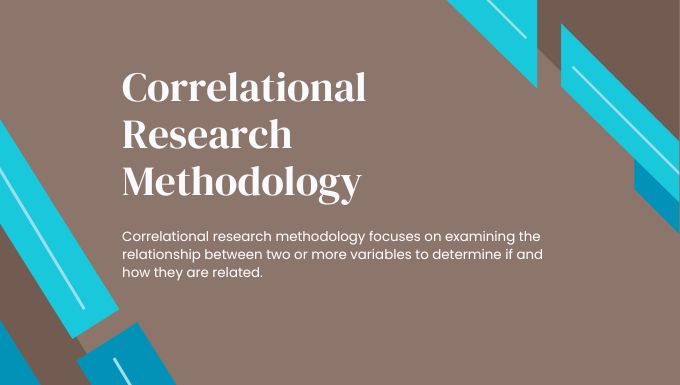
Correlational research methodology focuses on examining the relationship between two or more variables to determine if and how they are related. Unlike experimental research, correlational studies do not involve manipulating variables but rather measure them as they naturally occur.
This method aims to identify and quantify the strength and direction of relationships between variables, providing valuable insights into patterns, associations, and potential causal connections without establishing causality.
Definition and Characteristics of Correlational Research Methodology
Correlational research methodology is a type of non-experimental research that examines the relationship between two or more variables without manipulating them. It aims to determine the extent to which changes in one variable are associated with changes in another variable. Characteristics of correlational research include:
- Measurement of Variables: It involves measuring two or more variables to determine their relationship using statistical analyses.
- No Manipulation: Unlike experimental research, correlational studies do not involve manipulating variables; they simply observe and measure them as they naturally occur.
- Quantitative Analysis: Data collected in correlational research are typically analyzed using statistical methods to determine the strength and direction of relationships between variables.
- Associations, not Causation: Correlational research can identify patterns and associations between variables but does not establish causality. Correlation does not imply causation.
- Predictive Ability: Correlational studies can sometimes be used to predict the value of one variable based on the value of another variable, depending on the strength and nature of the relationship observed.
Overall, correlational research provides valuable insights into the relationships between variables, helping researchers identify patterns, trends, and potential connections that can guide further investigation or hypothesis testing in future research.
Understanding Correlation vs. Causation in Correlational Research Methodology
Understanding the distinction between correlation and causation is crucial when interpreting findings in correlational research methodology. Here’s a focused explanation within the context of correlational studies:
Correlation in Correlational Research:
- Correlation measures the strength and direction of the relationship between two or more variables in correlational research.
- A correlation coefficient, such as Pearson’s r, quantifies the degree to which changes in one variable are associated with changes in another variable.
- Correlation does not imply causation. Finding a correlation between variables does not mean that changes in one variable cause changes in the other variable.
Causation in Correlational Research:
- Correlational research is primarily descriptive and observational, focusing on identifying and measuring relationships between variables without manipulating them.
- Correlational studies can identify associations or patterns between variables but cannot determine causality.
- Establishing causation requires experimental research designs where variables are manipulated to determine if changes in one variable cause changes in another variable.
Key Considerations in Correlational Research:
- Avoid making causal conclusions based solely on correlational findings. Correlation does not prove causation.
- Recognize that other factors, known as confounding variables, may influence the observed relationship between variables in correlational studies.
- Correlational research is valuable for generating hypotheses, identifying relationships, and guiding further investigation but should be complemented by experimental research to establish causality.
While correlational research can identify and measure associations between variables, it does not provide evidence of causation. Researchers should be cautious when interpreting correlational findings and refrain from making causal claims without supporting experimental evidence.
Examples of correlational research methodologies
Examples of correlational research methodologies include:
- Observational Studies: Observational studies involve observing and measuring variables as they naturally occur without intervening or manipulating them. Researchers may observe and record behaviors, events, or conditions to identify patterns and associations between variables. For example, a study might observe the relationship between exercise habits and cardiovascular health by measuring exercise frequency and heart health indicators in a population.
- Surveys: Surveys are commonly used in correlational research to gather data on individuals’ attitudes, beliefs, behaviors, or characteristics related to the research variables. Participants respond to a series of questions designed to measure various factors, and statistical analyses are used to identify correlations between responses. For instance, a survey might examine the correlation between sleep quality and stress levels by collecting data on participants’ sleep patterns and perceived stress levels.
These examples demonstrate how observational studies and surveys can be utilized in correlational research to explore relationships between variables and identify patterns or associations without manipulating the variables.
5. Qualitative Research Methodology
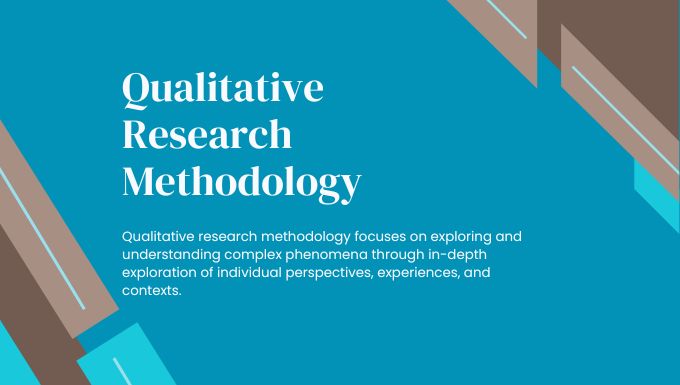
Qualitative research methodology focuses on exploring and understanding complex phenomena through in-depth exploration of individual perspectives, experiences, and contexts. Unlike quantitative research, which emphasizes numerical data and statistical analysis, qualitative research uses non-numerical data such as interviews, observations, and textual analysis to uncover deeper insights and meanings.
This approach aims to capture the richness, complexity, and context-specific nature of human experiences, beliefs, and behaviors, providing a comprehensive understanding of the research subject from the participants’ perspectives.
Definition and Characteristics of Qualitative Research Methodology
Qualitative research methodology is a systematic approach used to explore and understand the complexities of human behavior, experiences, and phenomena through non-numerical data collection and analysis. Characteristics of qualitative research include:
- In-depth Exploration: Qualitative research focuses on gaining a deep understanding of the research subject by exploring individual perspectives, experiences, and contexts in detail.
- Non-numerical Data: It relies on qualitative data sources such as interviews, focus groups, observations, and textual analysis to gather rich, descriptive data.
- Contextual Understanding: Qualitative research emphasizes understanding the context in which phenomena occur, considering social, cultural, and environmental factors that influence human behavior and experiences.
- Flexible and Emergent Design: Qualitative research often employs flexible research designs that allow for adaptability and the emergence of new themes or insights during the research process.
- Interpretative Analysis: Qualitative data are analyzed using interpretative methods to identify patterns, themes, and meanings, often resulting in narrative descriptions or thematic summaries.
Overall, qualitative research methodology aims to provide a nuanced, holistic understanding of the research subject by focusing on the depth, context, and richness of human experiences, behaviors, and interactions.
The Focus of Qualitative Research Methodology
Qualitative research methodology is primarily focused on understanding human behavior, experiences, and perspectives by delving deep into the complexities and nuances of individual and collective lived experiences. This approach aims to capture the richness, context, and subjective nature of human phenomena through in-depth exploration and analysis.
By employing methods such as interviews, observations, and textual analysis, qualitative research seeks to uncover underlying meanings, beliefs, values, and social processes that influence and shape human behavior and experiences.
This focus on understanding human complexities allows qualitative researchers to generate insights, develop theories, and provide contextually rich interpretations that contribute to a deeper understanding of the social world from the participants’ perspectives.
Examples: Interviews, Ethnographic Studies, Content Analysis
Examples of qualitative research methodologies include:
- Interviews: In-depth interviews are one-on-one conversations between the researcher and participants, aimed at exploring individual perspectives, experiences, and insights related to the research topic. Interviews can be structured, semi-structured, or unstructured, allowing for flexibility and depth in gathering qualitative data.
- Ethnographic Studies: Ethnographic studies involve immersive fieldwork where researchers observe and interact with participants in their natural settings to understand their cultures, behaviors, and social dynamics. Researchers immerse themselves in the community or group being studied to gain a holistic understanding of their experiences and practices.
- Content Analysis: Content analysis is a method used to analyze textual, visual, or audio content to identify patterns, themes, and meanings within the data. Researchers systematically analyze and interpret the content of documents, media, or artifacts to uncover insights into cultural, social, or psychological phenomena.
These qualitative research methods exemplify the focus on understanding human behavior, experiences, and perspectives by exploring the richness, context, and complexity of the research subjects in depth.
6. Quantitative Research Methodology
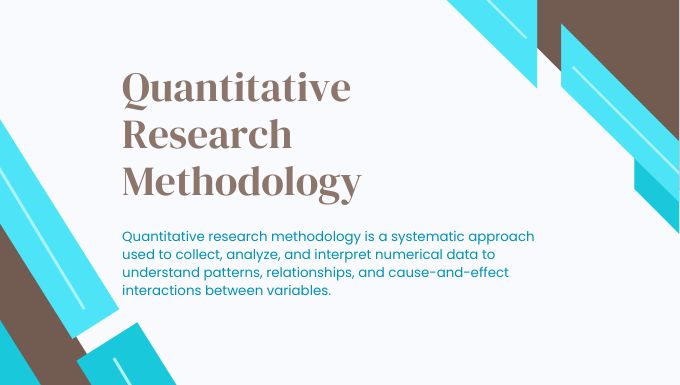
Quantitative research methodology is a systematic approach used to collect, analyze, and interpret numerical data to understand patterns, relationships, and cause-and-effect interactions between variables.
Unlike qualitative research, which focuses on exploring human experiences and perspectives in depth, quantitative research emphasizes objective measurement, statistical analysis, and generalizability of findings.
This method employs structured data collection tools such as surveys, experiments, and statistical analyses to quantify variables, test hypotheses, and identify statistical patterns and trends within the data.
Definition and Characteristics Quantitative Research Methodology
Quantitative research methodology is a systematic and structured approach to research that focuses on quantifying variables and analyzing numerical data to identify patterns, relationships, and trends. Characteristics of quantitative research include:
- Objective Measurement: Quantitative research relies on objective measurements and standardized data collection methods to ensure consistency and reliability in the research process.
- Statistical Analysis: It utilizes statistical methods and techniques to analyze and interpret numerical data, allowing researchers to test hypotheses, make predictions, and draw conclusions based on empirical evidence.
- Generalizability: Quantitative research aims to produce findings that are generalizable to a larger population, providing insights that can be applied beyond the specific sample studied.
- Controlled Environment: Quantitative research often takes place in controlled settings, such as laboratories or structured surveys, to minimize external influences and confounding variables.
- Structured Data Collection Tools: Quantitative research employs structured data collection tools such as questionnaires, surveys, experiments, or observational checklists to gather numerical data systematically.
Overall, quantitative research methodology provides a rigorous and systematic approach to studying phenomena by quantifying variables, employing statistical analyses, and emphasizing objectivity and generalizability in the research process.
The Focus of Quantitative Research Methodology
Quantitative research methodology focuses on the collection, analysis, and interpretation of numerical data to identify patterns, relationships, and trends within the data. This approach emphasizes objective measurement, statistical analysis, and the quantification of variables to provide empirical evidence and insights.
By employing structured data collection methods such as surveys, experiments, and observational studies, quantitative research aims to produce reliable and generalizable findings that can be statistically analyzed to test hypotheses, make predictions, and draw conclusions.
This focus on numerical data and statistical analysis enables researchers to quantify variables, assess relationships, and provide evidence-based insights into the phenomena under study.
Examples: Surveys, Experiments, Statistical Modeling
Examples of quantitative research methodologies include:
- Surveys: Surveys are structured data collection tools used to gather numerical data from participants through a series of standardized questions. Surveys can be administered in various formats, such as online questionnaires, face-to-face interviews, or telephone interviews, to collect quantitative data on attitudes, opinions, behaviors, or characteristics of a sample population.
- Experiments: Experiments involve manipulating one or more variables to observe the effect on another variable while controlling for confounding factors. Quantitative experiments use statistical methods to analyze the data collected and determine causal relationships between variables. Experimental designs often include control groups, random assignment, and manipulation of independent variables to test hypotheses and draw conclusions based on empirical evidence.
- Statistical Modeling: Statistical modeling encompasses a range of quantitative methods used to analyze and interpret data, including regression analysis, ANOVA (Analysis of Variance), and multivariate analysis. These statistical techniques allow researchers to identify patterns, relationships, and trends within the data, make predictions, and test hypotheses using mathematical models.
These examples illustrate how quantitative research methodologies focus on numerical data collection and statistical analysis to quantify variables, assess relationships, and provide empirical evidence in various fields of study.
7. Mixed Methods Research
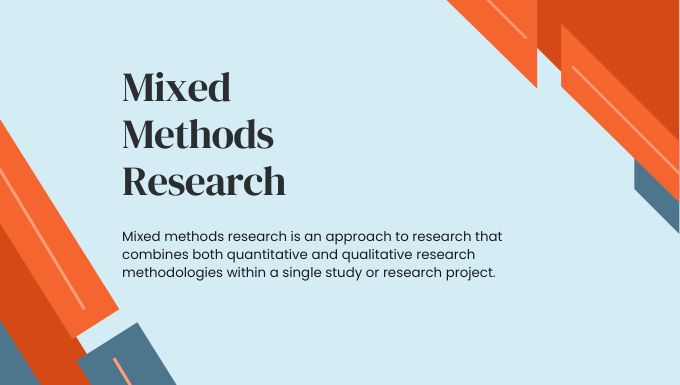
Mixed methods research is an approach to research that combines both quantitative and qualitative research methodologies within a single study or research project.
This integrated approach allows researchers to gather, analyze, and interpret both numerical and non-numerical data to gain a more comprehensive understanding of the research problem. By leveraging the strengths of both quantitative and qualitative methods, mixed methods research provides a balanced and nuanced perspective, capturing both the breadth and depth of the research subject.
This approach enables researchers to explore complex phenomena from multiple angles, validate findings across different data sources, and generate richer insights that may not be possible with a single methodological approach.
Definition and Characteristics of Mixed Methods Research
Mixed methods research is a research approach that combines both quantitative and qualitative research methods within a single study or research project. This methodological approach integrates the strengths of both quantitative and qualitative research to provide a more comprehensive understanding of the research problem or phenomena under investigation. Characteristics of mixed methods research include:
- Integration of Quantitative and Qualitative Data: Mixed methods research combines numerical data (quantitative) and textual or visual data (qualitative) to provide a multifaceted understanding of the research subject.
- Sequential or Concurrent Design: Mixed methods studies can be designed in a sequential manner, where one phase (quantitative or qualitative) is followed by another, or in a concurrent manner, where both methods are used simultaneously to collect and analyze data.
- Complementary Insights: The integration of quantitative and qualitative data allows researchers to gain complementary insights, validate findings, and explore the research problem from different perspectives, enhancing the robustness and validity of the research outcomes.
- Flexibility: Mixed methods research offers flexibility in adapting the research design, data collection methods, and analysis techniques to suit the research objectives and address the complexities of the research problem effectively.
- Complexity and Depth: By combining quantitative measures of trends and patterns with qualitative exploration of meanings, experiences, and contexts, mixed methods research enables researchers to capture the complexity and depth of the research subject in a more holistic manner.
Mixed methods research provides a flexible and robust approach to research, allowing researchers to capitalize on the strengths of both quantitative and qualitative methodologies to gain a deeper and more nuanced understanding of the research problem.
Integrating Qualitative and Quantitative Approaches
Combining qualitative and quantitative approaches in mixed methods research allows researchers to capitalize on the strengths of both methodologies, providing a more comprehensive and nuanced understanding of the research problem. Here’s how qualitative and quantitative approaches can be effectively combined:
- Sequential Design: In a sequential mixed methods design, researchers first collect and analyze quantitative data to identify patterns, trends, or relationships. This is followed by qualitative data collection and analysis to explore the underlying meanings, contexts, or explanations for the quantitative findings.
- Concurrent Design: In a concurrent mixed methods design, quantitative and qualitative data are collected and analyzed simultaneously. Researchers integrate both types of data during the interpretation phase to provide complementary insights and a holistic understanding of the research problem.
- Triangulation: Triangulation involves using multiple data sources, methods, or researchers to validate and corroborate the findings. By triangulating quantitative and qualitative data, researchers can enhance the validity, reliability, and credibility of the research outcomes.
- Complementarity: Quantitative data can help identify patterns or trends, while qualitative data can provide depth, context, and understanding of the human experience. Combining both approaches allows researchers to address the breadth and depth of the research problem effectively.
- Expansion and Exploration: Quantitative findings can guide qualitative exploration by identifying specific areas or themes to investigate further. Conversely, qualitative insights can inform the development of quantitative measures or hypotheses for further testing.
- Enhanced Interpretation: Integrating qualitative and quantitative data during the analysis and interpretation phases enables researchers to synthesize findings, identify relationships between variables, and develop richer, more nuanced explanations or theories.
Overall, combining qualitative and quantitative approaches in mixed methods research offers a flexible, robust, and holistic approach to studying complex research problems, allowing researchers to capture the multifaceted nature of the phenomena under investigation.
Examples: Surveys with Follow-up Interviews, Sequential Explanatory Design
Examples of combining qualitative and quantitative approaches in mixed methods research include:
- Surveys with Follow-up Interviews: Researchers can begin with a quantitative survey to collect numerical data on participants’ attitudes, behaviors, or experiences related to the research topic. Following the survey, qualitative follow-up interviews can be conducted with selected participants to explore their responses in-depth, providing context, explanations, and deeper insights into the quantitative findings.
- Sequential Explanatory Design: In a sequential explanatory mixed methods design, researchers first conduct quantitative research to identify patterns, trends, or relationships using surveys, experiments, or statistical analyses. Based on the quantitative findings, qualitative follow-up studies such as interviews, focus groups, or observations are conducted to explore and explain the results further. The qualitative data help interpret the quantitative findings, providing richer, more nuanced insights into the research problem.
These examples illustrate how combining qualitative and quantitative approaches in mixed methods research can enhance understanding, validation, and interpretation of research findings, offering a more comprehensive and holistic perspective on complex research problems.
Conclusion
In conclusion, research methodologies are essential tools that guide the process, outcomes, and interpretations of research studies. Whether using descriptive, exploratory, correlational, qualitative, quantitative, or mixed methods approaches, each methodology offers unique strengths for exploring and understanding research problems.
Understanding these methodologies helps researchers choose the most appropriate approach for their study, ensuring rigorous and meaningful research that contributes to knowledge advancement in various fields.